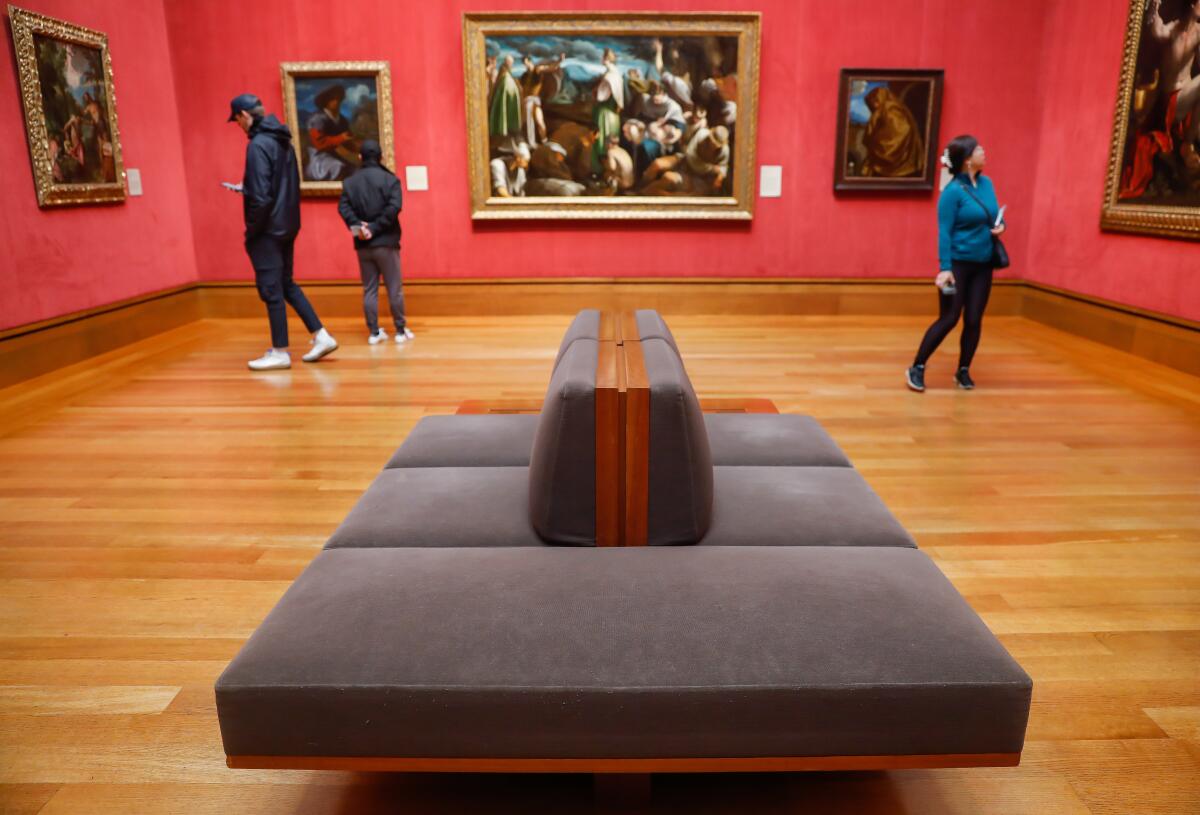The Getty has comfy benches, but food and drink in the galleries won’t sit well

The forbidden horchata
As a docent at the Getty Museum, I love that Carolina A. Miranda rates its seating A++ and “Best in Show” [“Sit-Down Bench Trial,” March 28].
Miranda writes that the benches are hospitable enough to “read the Sunday paper and drink my dirty horchata.” Just in case readers get the wrong idea: No eating or drinking is allowed in the galleries.
Not to worry, there are many beautiful spots all around the campus of the museum, with views and fountains, to enjoy your paper and horchata.
Laura Owen
Pacific Palisades
L.A. landmarks disappearing
Sadly, Kenan Draughorne’s article [“Harsh Notes at a Famed L.A. Studio,” March 26] confirms the continued dismantling of L.A.’s historic musical legacy. Our city has always been a mecca for creatives who shape the musical landscape worldwide. We should all want to keep it that way.
United Recordings (and similar storied sites like Capitol Studios) are L.A.’s equivalent of Abbey Road Studios, yet many look the other way as these landmarks are destroyed. Equally disturbing is laying off workers who are massive assets themselves, helping to curate legendary recordings out of these studios’ sonic spaces.
The historical site review did not warrant saving this landmark building because it did not have enough “unique architectural features” to qualify. Whoever conducts these reviews needs to update their criteria to include unique “aural” features. In United Recordings’ case, it could be based on proven acoustic design excellence.
After all, you can’t judge a historic book by its cover.
Matt Buguy
Hollywood
::
Your article about the shrinking infrastructure of L.A.’s recording scene (“Harsh Notes”) is an unintended indictment of the scandal that is our real estate industry. Our new land rush is creating a land-owning elite, where family inheritance will be the only path to homeownership for the vast majority of our population.
It is also creating collateral damage in the wider economy and our communal culture such as you report in the article: a real estate investment company, in this case Hudson Pacific Properties, using its vast ill-gotten gains to buy a thriving business, only to exploit its value.
Canada has enacted new laws restricting corporate investment in real estate, as well as laws banning international homeowners who have no intention of living in Canada.
Some Canadian cities have checked “flipping” by insisting that buyers must live in their new homes for at least one to three years, while luxury condos owned by absentee landlords are subject to tax. We must impose similar controls or cease bragging about our land of opportunity and, closer to home, having L.A.’s cultural gems, like our world-renowned recording studios and their artists, stolen from us.
David Impastato
Los Angeles
The forgotten writer
I was interested in reading Charles Arrowsmith’s review [“A ‘Shining’ Collector’s Dream,” March 26] of Lee Unkrich and J.W Rinzler’s “Stanley Kubrick’s ‘The Shining.’” Notice how I included all the authors of that new work?
It’s a shame that nowhere in the review did Arrowsmith mention that the film was co-written by Diane Lain Johnson, novelist and co-screenwriter on the project. It’s yet another example of how easily women are left out of history by unreliable narrators.
It’s also another annoying example of the outdated auteur theory in that you use the possessive “Kubrick’s ‘The Shining’” when it is based on a novel by none other than Stephen King, which was adapted by Kubrick and Johnson and acted brilliantly — so it never belonged to Kubrick alone.
I have recently interviewed Johnson (who at 93 lives in Paris as the author of over 12 novels including one published two years ago) and learned many interesting behind-the-scenes facts.
I wonder if this new book can be a “complete” look at the film if it included an interview with a man whose finger froze to the lens due to this celebration of obsessive (and toxic) masculine directing but doesn’t include an interview with the female writer who was on location doing all the daily rewrites as Kubrick famously took forever figuring out where to place a camera.
And don’t get me started on how the Shelley Duvall character changed from novel to film, despite the pages Johnson sent to Kubrick each day.
Unreliable narrators continue to write women out of history, and it’s one of my goals to write them back in.
Rosanne Welch
Van Nuys
Fascism on the march
Regarding “A Rising Tide of U.S. Fascism,” Stuart Miller’s review of Jeff Sharlet’s book “The Undertow: Scenes From a Slow Civil War” [March 23]: there is no doubt we have a rising tide of fascism in our country — more akin to a tsunami — in fact.
We have all the hallmarks — support for “strongmen” with questionable ethics, rabid exaltation of our “dear leader,” turning a blind eye to corrupt motives plus rising violence and racism.
I agree with many of Jeff Sharlet’s observations but differ when it comes to the unfortunate Ashli Babbitt, whom the right has turned into their Joan of Arc. She was shot because she flung herself through a window leading to the House Chamber where members of Congress were sheltering in place protected by armed guards. This woman might have reflected in the midst of this riotous mob prior to her actions — “Is this really a good idea?” — but she did not and she was shot while the Capitol Police bravely protected defenseless members of Congress. A victim she is not.
The day before the insurrection, Babbitt wrote, “Nothing will stop us, They can try and try and try but the storm is here and it is descending upon DC in less than 24 hours.”
Prophetic and planned.
By contrast, Officer Brian Sicknick — who many on the right disparage — had two strokes and died the day after being assaulted in the riot by this same lawless mob. The medical examiner stated, “All that transpired played a role in his condition.” He among others are the true victims and are truly deserving of our respect and gratitude.
Such is the topsy-tipsy world of “acumen” or lack thereof in our current political environment.
Jan Jay Judah
Torrance
Extras in the background
Comedian Jen Murphy’s article on the travails of movie background performers [“Embracing Life as the Backdrop,” March 27] brought back memories of my experience with becoming an extra in a movie.
During the 1950s I worked in New York City. My office overlooked Rockefeller Plaza. One day I noticed that the movie “Solid Gold Cadilac” was being filmed there starring Judy Holliday. The movie studio had hired extras for background scenes. During my lunch hour I decided to join the extras. Nobody noticed.
Several months later my husband and I were vacationing on Cape Cod. I noticed an advertisement in the local newspaper that “Solid Gold Cadillac” had opened in a neighboring town. Not realizing that the theater was about 50 miles from our hotel, we decided to see my acting debut. It turned out that my scene was left on the cutting-room floor. So much for show business.
Bunny Landis
Oceanside
::
Murphy’s article reminds me of the adage that I repeat often to myself and others: The only way to ensure that you fail is to quit. I hope to see Murphy in a Netflix show of their own ASAP.
Randy Farhi
Los Angeles
More to Read
The biggest entertainment stories
Get our big stories about Hollywood, film, television, music, arts, culture and more right in your inbox as soon as they publish.
You may occasionally receive promotional content from the Los Angeles Times.











